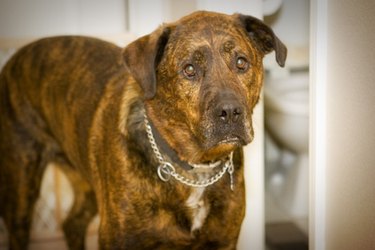
A perianal adenoma tumor is more common in older male non-neutered dogs. However, it can be seen in neutered males and rarely in female dogs. A perianal adenoma tumor is most often benign, and occurs in the cells of the oil glands of the tail area. When found in the female or the neutered male, though, chances are higher that the tumor may be malignant.
Significance
Video of the Day
Perianal gland tumors, according to Mtvtimes.com and Asecvet.com, can cause pain and become ulcerated or infected. These tumors can also occur in the dorsal midline and ventral abdomen. The rare perianal adenoma in a neutered male usually suggests an underlying hormonal abnormality such as hyperadrenocorticism (Cushing's disease). Perianal adenocarcinomas (malignant perianal adenoma tumors) are not affected by hormone levels, and many times occur in the neutered male. This is a slow-growing cancer, with potential to spread to the regional lymph nodes and other distant sites such as the liver or lungs.
Video of the Day
Clinical Diagnosis
Your dog must undergo a thorough physical examination. Your vet may order an ultrasound and X-rays, urinalysis, an aspiration biopsy of the tumor, a complete blood count and a serum chemistry profile. Since your dog has already been neutered, it is important to know any underlying conditions and if the perianal adenoma tumor is malignant.
Surgery
Surgery involves removing the tumor and sending it to a pathologist for a histopathology examination. The surrounding tissues will be examined to reveal any metastasis of the tumor. Your veterinarian will advise on whether to follow the surgery with chemotherapy and/or radiation, depending on severity and if the tumor is a perianal benign adenoma or malignant adenocarcinoma. There may be some fecal incontinence postoperatively, which is sometimes permanent. Anti-inflammatory drugs such as Rimadyl, Deramaxx, or Metacam, help for pain control, but bowel movements should be monitored. Use stool softeners/lubricant laxatives if your dog seems to be in pain when defecating.
Cryotherapy
If your dog's tumor appears to be rather minor and small, it may be removed through cryotherapy in which the tumor is frozen with liquid nitrogen. There might be some minor fecal incontinence for the first week following this procedure.
Post-Operative Treatment/Home Care
Post-surgical treatment and home care depends on the extent and type of tumor, plus any post-operative therapy. Your vet may prescribe pain or anti-inflammatory medications plus an antibiotic to prevent infection while your dog is healing. An Elizabethan collar is often required to prevent your dog from disturbing the affected area during recovery.
Always check with your veterinarian before changing your pet’s diet, medication, or physical activity routines. This information is not a substitute for a vet’s opinion.